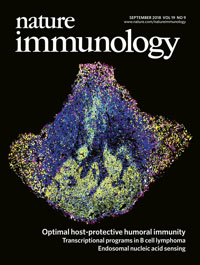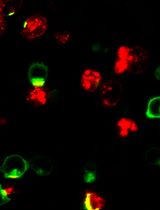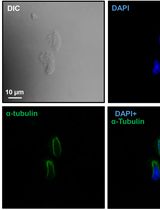- EN - English
- CN - 中文
DNA Immunization Using in vivo Electroporation for Generating Monoclonal Antibodies Against Mouse IL-9R
利用体内电穿孔产生小鼠IL-9R单克隆抗体进行基因免疫
(*contributed equally to this work) 发布: 2019年02月20日第9卷第4期 DOI: 10.21769/BioProtoc.3174 浏览次数: 7014
评审: Ivan ZanoniYang FuDana Manuela Savulescu

相关实验方案
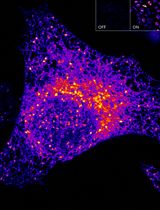
高灵敏且可调控的 ATOM 荧光生物传感器:用于检测细胞中蛋白质靶点的亚细胞定位
Harsimranjit Sekhon [...] Stewart N. Loh
2025年03月20日 2166 阅读
Abstract
Membrane proteins such as cytokine receptors and G protein-coupled receptors can be drug targets. Recently, we have generated specific monoclonal antibodies (mAbs) against the mouse IL-9 receptor (IL-9R) and found that IL-9R on memory B cells have critical roles in T-dependent immune response. So far, most antibodies against cell surface proteins have been generated by immunization of animals with recombinant proteins produced in Escherichia coli (E. coli) or peptides derived from the protein. However, such antibodies often fail to recognize native proteins on cell surfaces because these antigens lack posttranslational modification and natural protein conformations. To circumvent such problems, we have developed a mouse immunization method, the DNA-immunization utilizing hyaluronidase and E. coli GroEL. Herein, we report an application of the original mouse immunization method in rats to generate anti-mouse IL-9R mAbs which could react with the native form of mouse IL-9R on cell surfaces. Thus, we suggest that the DNA-immunization method is feasible for generating monoclonal antibodies against cell surface proteins in rats.
Keywords: IL-9 receptor (IL-9受体)Background
Membrane proteins such as cytokine receptors and G protein-coupled receptors have been regarded as medicinal drug targets, and generation of antibodies reactive with the native form of such membrane proteins would lead to antibody-drug development. However, most antibodies generated so far by immunization with a recombinant protein produced in Escherichia coli react only with the immunizing recombinant proteins, but not with the native proteins on cell surfaces. The same problems have often been experienced with immunization with peptides as antigens. In order to generate mAbs which could recognize the native proteins, we have developed the original DNA-immunization method in which plasmid DNA is directly transferred into mouse skeletal muscle in vivo utilizing Escherichia coli (E. coli) GroEL (Fujimoto et al., 2009; Takatsuka et al., 2011) and hyaluronidase. E. coli GroEL, is a molecular chaperone that is responsible for the transportation and refolding of proteins and GroEL fusion proteins are highly expressed in the soluble fraction (Furutani et al., 2005). Further, E. coli GroEL also acts as an adjuvant via TLR4 (Fujimoto et al., 2012). Pre-treatment with hyaluronidase enhances gene expression by prevention of tissue damage (McMahon et al., 2001). Furthermore, low molecular weight hyaluronan produced by hyaluronidase in vivo provides adjuvant effects via TLR2 and TLR4 (Scheibner et al., 2006, Gariboldi et al., 2008). The striated muscle is an excellent tissue for taking up and expressing genes that are transferred in the form of plasmid DNA (Wolff et al., 1990 and 1992, Davis et al., 1993; Ulmer et al., 1993; Aihara and Miyazaki, 1998). The longevity of myofibers allows the stable expression of transfected exogenous genes. Once induced, the expression of the transduced gene can last for at least 70 days thereafter (Wolff et al., 1990 and 1992; Davis et al., 1993; Ulmer et al., 1993; Yamazaki et al., 2011) and the expressed antigens are continuously exposed to the host immune system.
In the present paper, we report an application of the mouse DNA-immunization method in rats in order to generate anti-mouse IL-9R mAbs. IL-9 receptor (IL-9R) is composed of the IL-9Rα and common γ chains and is expressed on mast cells, basophils, ILC2 cells and others (Renauld et al., 1992, Bauer et al., 1998; Noelle and Nowak, 2010; Wilhelm et al., 2011; Licona-Limón et al., 2013). IL-9 is produced by various immune cells, such as activated T cells (exemplified by TH9 cells), mast cells, eosinophils, and type 2 innate lymphoid cells (ILC2 cells), and induces various functions depending on the target-cell types expressing its receptor (IL-9R) (Gounni et al., 2000; Stassen et al., 2000; Noelle and Nowak, 2010; Wilhelm et al., 2011; Licona-Limón et al., 2013). Thus, IL-9/IL-9R signaling is mainly involved in immune responses such as allergic inflammations. We successfully generated four rat-mouse hybridomas producing mAbs that react with the native form of mouse IL-9R on cell surfaces. Using these mAbs, we found that IL-9R is selectively expressed on memory B cells among B-lineage cells in the T-cell-dependent immune response. We also found that IL-9R is induced on B cells by stimulation through CD40, but suppressed by IL-4 or IL-21, which may explain the minimum expression of IL-9R on germinal center B cells (Takatsuka et al., 2018). Thus, rat mAbs generated by the DNA-immunization method turned out to be quite reliable tools in staining cell surface proteins, and this method can be extended to immunization for various cell surface antigens against which specific mAbs are yet to be obtained.
Materials and Reagents
- Absorbent cotton
- 1 ml syringes (Terumo, catalog number: SS-01T)
- 26 G needles (Terumo, catalog number: NN-2613S)
- Micro slide glass (Matsunami, catalog number: S-2226)
- Cell strainer (Thermo, catalog number: 08-771-2)
- Cell lines
- B300-19 cells
IL-9R/B300-19 and EV/B300-19 cells: B300-19 cells (a mouse pre-B cell line), transduced with a retroviral vector containing Il9r cDNA (pMXs-IL9R-IRES-hNGFR) or an empty vector (EV; pMXs-IRES-hNGFR). The B300-19 cell line was provided by Dr. Takashi Nakayama. The retroviral vectors and B300-19 transfectants generated by us will be available upon request. - Plat-E cells
The Plat-E cell line and an original pMXs vector were provided by Dr. Toshio Kitamura.
- B300-19 cells
- Lew/SSN rats (Female Lew/SSN rats were purchased from Sankyo Lab Service. Rats were immunized at 4 weeks of age)
- Depilatory cream (general commercialized product)
- Sodium pentobarbital (Kyoritsu Seiyaku, Somnopentyl Injection)
- QIAGEN Plasmid Giga Kit (QIAGEN, catalog number: 12191)
- Fugene HD (Promega, catalog number: E2311)
- FITC-conjugated secondary antibodies [FITC-conjugated goat anti-rat IgG (H+L)] (SouthernBiotech, catalog number: 3050)
- FITC-anti-IgG1 (BD Bioscience, catalog number: 562580)
- PE-anti-CD138 (Biolegend, catalog number: 142503)
- PE-anti-IgM (Thermo, catalog number: 12-5790-81)
- PE-anti-IgD (Biolegend, catalog number: 405705)
- PerCP/Cy5.5-anti-T and -B Cell activation antigen clone GL-7 (Biolegend, catalog number: 144609)
- PE/Cy7-anti-CD38 (Thermo, catalog number: 25-0381-80)
- APC/Cy7-anti-B220 (Biolegend, catalog number: 103223)
- Biotin-NP14-BSA (in house)
- Brilliant Violet 421 Streptavidin (Biolegend, catalog number: 405226)
- MEM medium (Thermo, catalog number: 11095080)
- Hyaluronidase (Sigma, catalog number: H3631-30KU)
- 70% (v/v) Ethanol
- Phosphate buffered saline (pH 7.4)
- Tris
- EDTA
- Sodium azide
- Hyaluronidase solution (see Recipes)
- Tris-EDTA buffer (see Recipes)
- FACS Buffer (see Recipes)
- Plasmid DNA solution (see Recipes)
Equipment
- Electroporator (BTX, Electro Square Porator ECM830, Figure 1A)
- Copper cables with IC hook (Toyoshima, made-to-order or general commercialized product, length: more than one meter, Figure 1A-1B)
- 26 G two-stage needle (Toyoshima, made-to-order, Figure 1C-1D)
- Gamma irradiation device (Atomic Energy of Canada Limited, Gammacell 40)
- BD FACS Calibur
- BD FACS CantoII
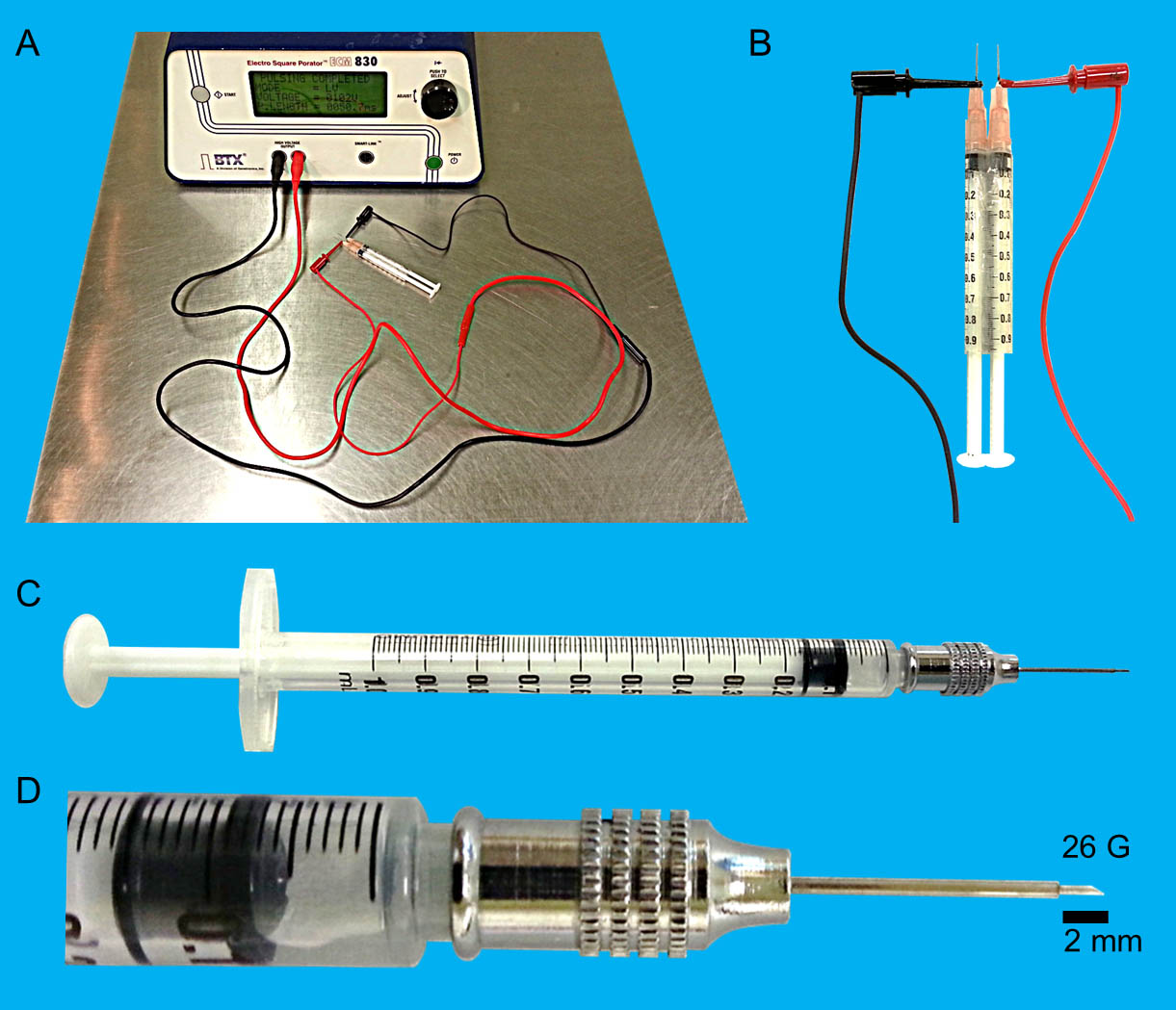
Figure 1. Details of the experimental equipment for DNA immunization. A. Electroporator. B. Electrodes and copper cables with IC hook. C. 1 ml syringe with a 26 G two-stage needle. D. 26 G two-stage needle.
Software
- FlowJo (Tree Star, https://www.flowjo.com)
Procedure
文章信息
版权信息
© 2019 The Authors; exclusive licensee Bio-protocol LLC.
如何引用
Takatsuka, S., Yamada, H., Haniuda, K., Ichihashi, M., Chiba, J. and Kitamura, D. (2019). DNA Immunization Using in vivo Electroporation for Generating Monoclonal Antibodies Against Mouse IL-9R. Bio-protocol 9(4): e3174. DOI: 10.21769/BioProtoc.3174.
分类
免疫学 > 抗体分析 > 抗体-抗原相互作用
免疫学 > 抗体分析 > 抗体检测
分子生物学 > 蛋白质 > 检测
您对这篇实验方法有问题吗?
在此处发布您的问题,我们将邀请本文作者来回答。同时,我们会将您的问题发布到Bio-protocol Exchange,以便寻求社区成员的帮助。
Share
Bluesky
X
Copy link




